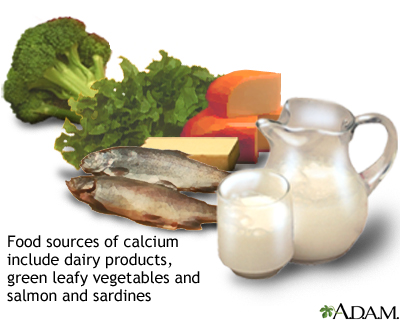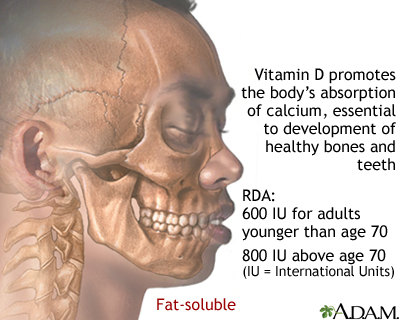Osteoporosis, or weak bones, is a disease that causes bones to become brittle and more likely to fracture (break). With osteoporosis, the bones lose density. Bone density is the amount of calcified bone tissue that is in your bones.
A diagnosis of osteoporosis means you are at risk for bone fractures even with everyday activities or minor accidents or falls.
Your Changing Bones
Your body needs the minerals calcium and phosphate to make and keep healthy bones.
- During your life, your body continues to both reabsorb old bone and create new bone. Your entire skeleton is replaced about every 10 years, though this process slows as you get older.
- As long as your body has a good balance of new and old bone, your bones stay healthy and strong.
- Bone loss occurs when more old bone is reabsorbed than new bone is created.
Sometimes bone loss occurs without any known cause. Some bone loss with aging is normal for everyone. Other times, bone loss and low bone density run in families and the condition is inherited. In general, white, older women are the most likely to have bone loss. This increases their risk of breaking a bone.
Brittle, fragile bones can be caused by anything that makes your body destroy too much bone, or keeps your body from making enough bone.
Weak bones can break easily, even without an obvious injury.
Bone mineral density is not the only predictor of how fragile your bones are. Consuming alcohol, smoking, and a sedentary lifestyle all increase the risk of having fragile bones. There are other unknown factors related to bone quality that are as important as bone quantity. Most bone density tests only measure the bone quantity.
Aging and Bone Loss
As you age, your body may reabsorb calcium and phosphate from your bones instead of keeping these minerals in your bones. This makes your bones weaker. When this process reaches a certain stage, it is called osteoporosis.
 Watch this video about:Osteoporosis
Watch this video about:OsteoporosisMany times, a person will fracture a bone before they even know they have bone loss. By the time a fracture occurs, the bone loss may be serious.
Women age 50 and older and men age 70 and older have a higher risk for osteoporosis than younger women and men.
- For women, a drop in estrogen at the time of menopause is a major cause of bone loss.
- For men, a drop in testosterone as they age can cause bone loss.
Your Lifestyle and Bone Loss
Your body needs calcium and vitamin D and enough exercise to build and keep strong bones.


Your body may not make enough new bone if:
- You do not eat enough high-calcium foods
- Your body does not absorb enough calcium from the foods you eat
- Your body loses more calcium than normal in the urine
Certain habits can affect your bones.
- Drinking alcohol. Too much alcohol can damage your bones. It can also put you at risk of falling and breaking a bone.
- Smoking. Men and women who smoke have weaker bones. Women who smoke after menopause have an even higher chance of fractures.
Younger women who do not have menstrual periods for a long time also have a higher risk of bone loss and osteoporosis.
Low body weight is linked to less bone mass and weaker bones.
Exercise, especially weight-bearing exercise, is linked to higher bone mass and stronger bones.
Medical Disorders and Bone Loss
Many long-term (chronic) medical conditions can keep people confined to a bed or chair.
- This keeps the muscles and bones in their hips and spines from being used or bearing any weight.
- Not being able to walk or exercise may lead to bone loss and fractures.
Other medical conditions that may also lead to bone loss are:
- Rheumatoid arthritis
- Long-term (chronic) kidney disease
- Overactive parathyroid gland
- Diabetes, most often type 1 diabetes
- Organ transplant
Sometimes, medicines that treat certain medical conditions can cause osteoporosis. Some of these are:
- Hormone-blocking treatments for prostate cancer or breast cancer
- Some medicines that are used to treat seizures or epilepsy
- Glucocorticoid (steroid) medicines, if they are taken by mouth every day for more than 3 months, or are taken several times a year
Any treatment or condition that causes calcium or vitamin D to be poorly absorbed can also lead to weak bones. Some of these are:
- Gastric bypass (weight-loss surgery)
- Cystic fibrosis
- Other conditions that prevent the small intestine from absorbing nutrients well
People with eating disorders, such as anorexia or bulimia, are also at higher risk for osteoporosis.
What's Next?
Talk to your health care provider about your risk for bone loss and osteoporosis. Find out how to get the right amount of calcium and vitamin D, what exercise or lifestyle changes are right for you, and what medicines you may need to take.
Alternative Names
Osteoporosis - causes; Low bone density - causes
Images
References
Bone Health and Osteoporosis Foundation. What is osteoporosis and what causes it?www.bonehealthandosteoporosis.org/patients/what-is-osteoporosis/. Accessed June 12, 2024.
De Paula FJA, Black DM, Miller PD, Rosen CJ. Osteoporosis: basic and clinical aspects. In: Melmed S, Auchus RJ, Goldfine AB, Rosen CJ, Kopp PA, eds. Williams Textbook of Endocrinology. 15th ed. Philadelphia, PA: Elsevier; 2025:chap 29.
Shoback D, Rosen CJ, Black DM, Cheung AM, Murad MH, Eastell R. Pharmacological Management of Osteoporosis in Postmenopausal Women: An Endocrine Society Guideline Update. J Clin Endocrinol Metab. 2020;105(3):dgaa048. PMID: 32068863 pubmed.ncbi.nlm.nih.gov/32068863/.
Weber TJ. Osteoporosis. In: Goldman L, Cooney KA, eds. Goldman-Cecil Medicine. 27th ed. Philadelphia, PA: Elsevier; 2024:chap 225.
Test Your Knowledge
Review Date 5/20/2024
Updated by: Sandeep K. Dhaliwal, MD, board-certified in Diabetes, Endocrinology, and Metabolism, Springfield, VA. Also reviewed by David C. Dugdale, MD, Medical Director, Brenda Conaway, Editorial Director, and the A.D.A.M. Editorial team.




